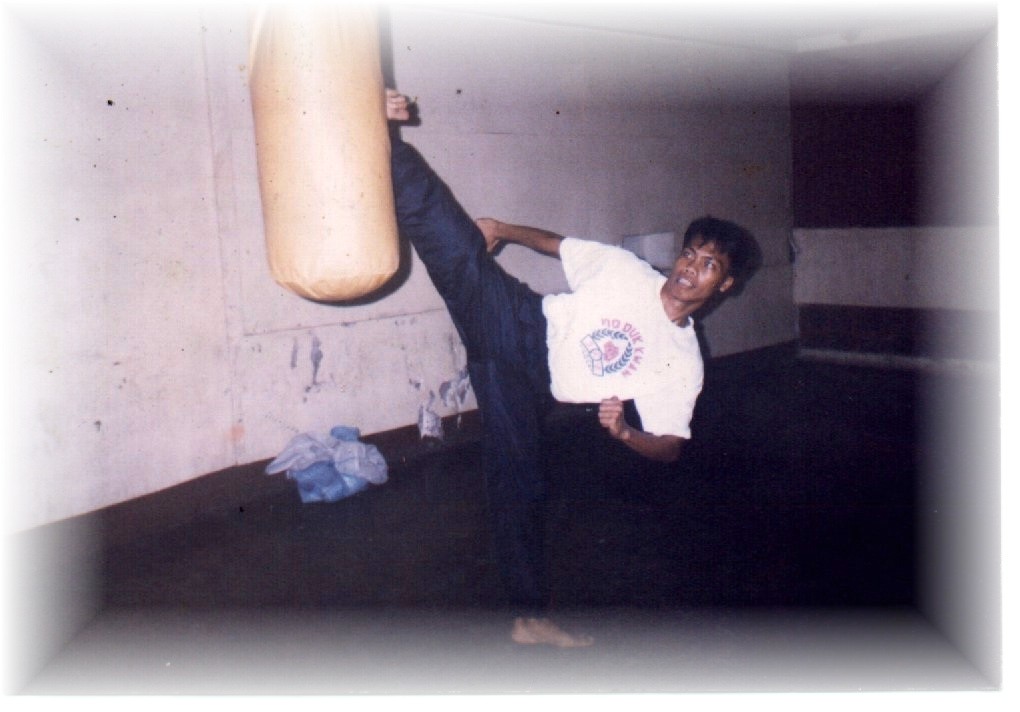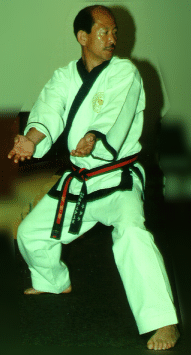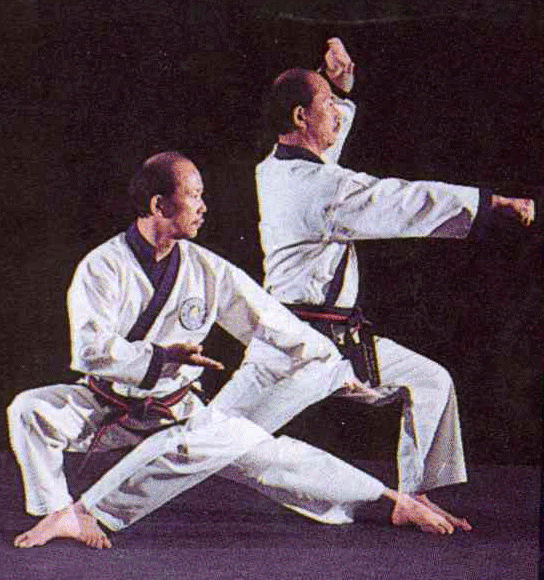The Tang in Tang Soo Do
This is a reprint of an article originally published in Inside Tae Kwon Do magazine in August 1994.
 Practitioners of Tang Soo Do often hear how their art is based upon the martial arts of the Chinese warrior; yet frequently the techniques and forms the student learns bears little resemblance to what we see practiced by students of Kung Fu or Wu Shu. The key to unlocking the secret of the "Tang" - or "China" - in Tang Soo Do is to broaden one's approach to its study and practice.
Practitioners of Tang Soo Do often hear how their art is based upon the martial arts of the Chinese warrior; yet frequently the techniques and forms the student learns bears little resemblance to what we see practiced by students of Kung Fu or Wu Shu. The key to unlocking the secret of the "Tang" - or "China" - in Tang Soo Do is to broaden one's approach to its study and practice.
To unlock the secret of the Tang in Tang Soo Do, you must do four things. First, you must have a strong foundation in basic technique. Second, you must change the way you think about and apply these basics. Third, you must understand the physics and mechanics of the body and how these are harmonized with a universal design. Fourth and last, you know and understand the history of not just Tang Soo Do, but of the Korean people and their neighbors during the development of these martial arts.
Beginning your study, you must have an appreciable skill with the gicho sool, or foundation technique; the basics. Without this stone to build on, your temple (that is, your art) will not stand.
Next you must change how you perceive the technique. In Tang Soo Do we speak of many techniques as being mahk ki, which we often call a 'block'. While mahk ki does translated as 'to block or deflect', there are other translations that are not often explored which shed a different light on a differing paradigm. Mahk (or mok) refers to the area of the body we associate as being the wrist. Ki (or Kee) simply means 'technique'. So, mahk ki actually refers to any number of techniques involving the 'wrist area' of the body.
With this understanding, we can now change our perception of the technique from being a 'block' (i.e. defensive) to a 'strike' (i.e. offensive). In truth, all techniques we refer to as 'blocks' are in reality strikes. They are merely defensive strikes even when applied only to an opponent's arm.
The question must arise, "If the block is the strike, then where is the defense against the attack?" Once you begin to view your body as a complementary whole instead of as parts (i.e., right arm, left arm, head, etc.), the defense becomes apparent in the preparatory motion of any technique. It is in the act of chambering that we defend. This defense may include our body shift (evading), our stance (posture), and our chamber (the true block).
During the preparatory motion (i.e., the chamber), we close to protect our vital organs. In the process of protecting vulnerable areas, we also perform defensive motion, the block. For example, by lowering one arm across the body and raising the other to protect the face, we create an Um/Yang
Chamber. As we complete the technique's motion, we execute the offensive motion - the strike. This change in our perspective allows us to block and strike as one motion.
It is of interest to note here that often we are instructed to inhale while defending and exhale while attacking. Once one begins to take notice of a technique's total properties, it becomes apparent that when we close to defend during the chamber, we also instinctively inhale. As we expand and move out to complete the technique, we exhale as we strike. In performing in this manner, we not only find the technique enhanced, but we find our body motion is harmonized naturally.
Additionally, when one closely examines the paths that limbs in motion follow, an elliptical arc can be discerned. To prove this, stand with both arms hanging relaxed at your sides. Begin slowly rotates from side to side. Remember to keep your arms totally relaxed. After a few rotations, you should begin to notice that your arm will cross low in front of your body, and as you rotate back in the opposite direction, the hand will have a tendency to want to rise, performing an arc as it crosses back in front of you. Observing the hand, you should note that the path it traces is an ellipse. You may initially have difficulty perceiving this, but if each change in direction is driven by a strong waist action, it will become clear.
Our understanding of physics, body motion, and universal principles refines our expertise in application of technique:
- 1. Gravity pulls down.
- 2. Inertia applies: a body in motion tends to stay in motion.
- 3. Angular changes in motion require greater expense of energy than gradual changes in Vector (i.e., a circular motion is most economical in accelerating/decelerating between any two points not already on a common plane. This is especially true where either one or both points are bodies already in motion).
- 1. The body works by rotational forces.
- 2. The body instinctively reacts to protect itself.
-
3. The body works best where there is a complementary dichotomy of motion (i.e., left
goes out, right comes in).
UNIVERSAL PRINCIPLES - 1. The universe moves through ellipse (i.e., oblong circles).
- 2. Um/Yang applies: the concept of opposite and yet complementary natures exist as a reality. You must have a "left" to know what a "right" is. If you want to move something to a "high" position, it must be in a "low" position to begin (i.e., spatial relativity).
Now, by combining this knowledge and putting it into application, we perform any technique by knowing it should:
- 1. Begin by being in a relatively opposite position than where we want it to end up at.
- 2. It should move in an elliptical path so we can gradually increase its speed (i.e., power) up to a point of impact.
- 3. It should be coordinated with a complementary but opposite motion in the body.
- 4. It should meet its target at an angle and not straight on.
- 5. It should take advantage of gravity whenever possible in assisting in pulling it into the target.
- 6. It should involve rotational forces in the body (i.e., the hips or shoulders should move, the forearm should twist or rotate, etc.).
- 7. Proper breathing should be harmonized to the technique (breathe in as you move in, out as you move out).
The whole effect will be to make the technique appear smooth and circular. Not a lot unlike what we have come to associate as typical of Chinese Kung-Fu or Wu Shu technique. Once these mechanics are grasped, the technique may then be applied as a whole toward defense and offense simultaneously.
The effect of any technique is enhanced by knowledge of sensitive points of human anatomy. This knowledge and its applications are classified as Keupso Chirigi among Korean martial art practitioners.
Now the technique is changed in perspective so that it may be used not only to strike an attacking limb, but the attacker himself, allowing us to quickly incapacitate and subdue his aggression.
The "Tang" in Tang Soo Do "Okay! But what makes this the "Tang" in Tang Soo Do?" you are asking. The answer is, "Because all of these principles were known in some form to ancient Chinese martial artists." The Korean people have a history of contact with the Chinese, and this is why it is important to know the history of Korea and its neighbors.

During the Unified Silla Dynasty (618 to 935 a.d.), the Korean people had several occasions to exchange knowledge, to integrate military tactics, and adopt cultural aspects with the Chinese. This same time period coincides with the "Tang" Dynasty (618 to 906 a.d.) in China.
The first forms of Tai Chi Chuan were developed in China during this time period. It was then that scholars of martial arts first formulated and wrote down many of the principles outlined in this article. The Koreans have had an opportunity to access this knowledge and apply it with their own interpretations. The Koreans refer to Tai Chi Chuan as Tae Keuk Kwon. Many of the principles outlined in ancient Chinese treatise for the development of jing ("power"), is the same as utilized by Tang Soo Do practitioners.
Additionally, during the Koryo Dynasty (935 to 1392 a.d.) the Koreans established peaceful relations with China (coinciding with China's Sung Dynasty - 960 to 1279 a.d.), and much of China's culture and knowledge was adopted and adapted into the Korean way.
In China, a great General known as Marshall Yeuh Fei lived and developed several martial art systems to include Hsing I and Eagle Claw Kung-Fu styles. These he taught to the Sung military as required training for every soldier. During the Koryo Dynasty, the Koreans adopted many of these techniques, which were referred to as Kwon Bup, and which were cataloged in the text Moo Ye Dobo Tong Ji. This classic is still studied by Tang Soo Do practitioners today (the Japanese/Okinawan similarity is the Bubishi). Many of the mahk ki of Tang Soo Do have similarities to the Five Form Fists of the Hsing I style.
Tang Soo Do in recent years has been undergoing change. Change is not a bad thing, but if a practitioner, or just an appreciative bystander, wants to really understand this art, it behooves them to strive for as much of a universal investigation as possible. While being able to use Tang Soo Do techniques could be considered the meat and potatoes of the art, it is the deep understanding of the principles, the history, and the cultures from which the art evolves from that is the seasoning that makes Tang Soo Do so palatable.
At the time this article was first written back in 1994, John Hancock was a 4th Dan in Tang Soo Do. Master Hancock invites your comments this and any article and can be sent via e-mail to: copyright 1997 [email protected]